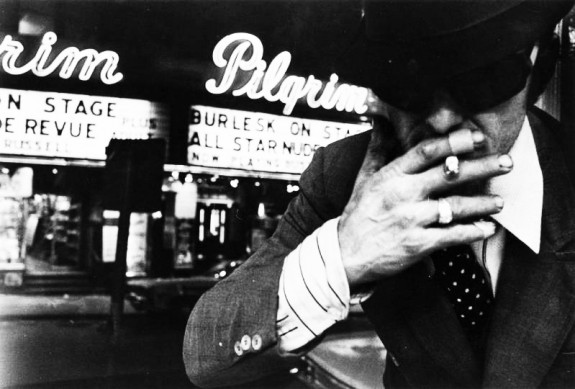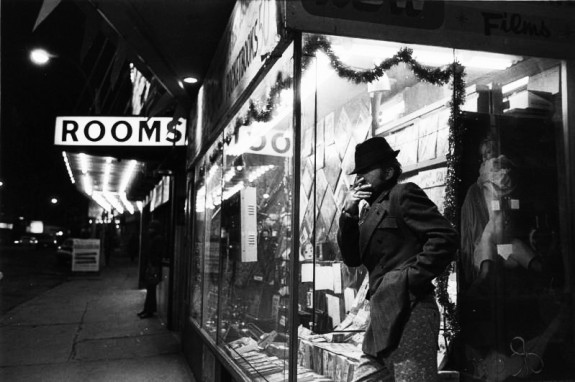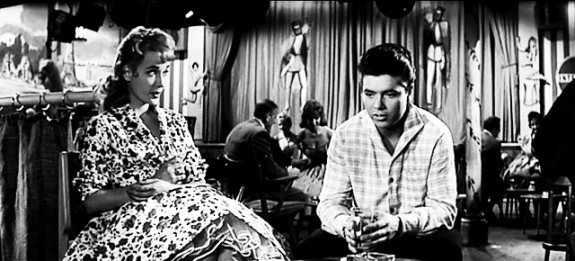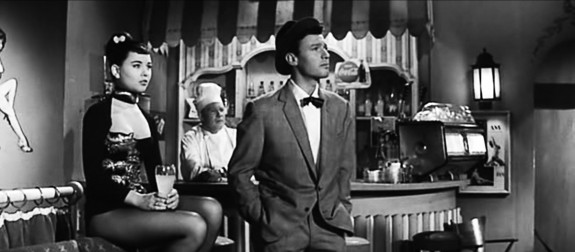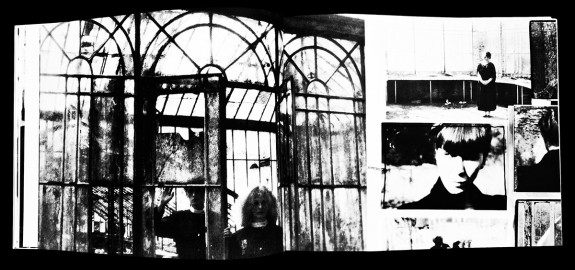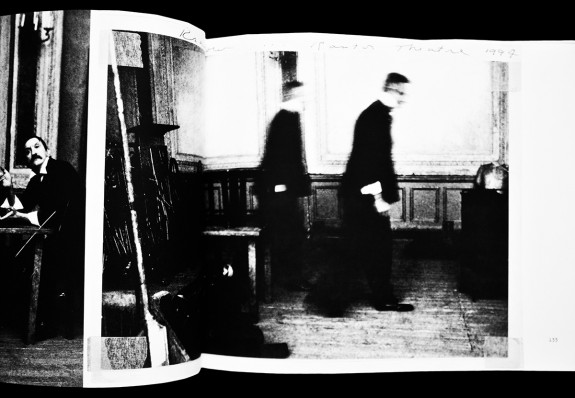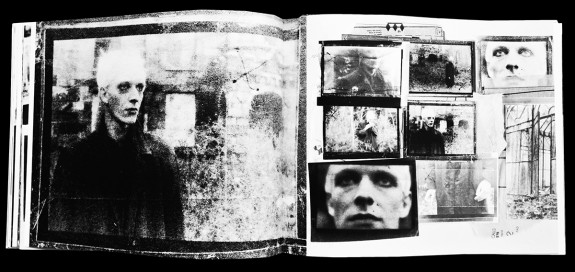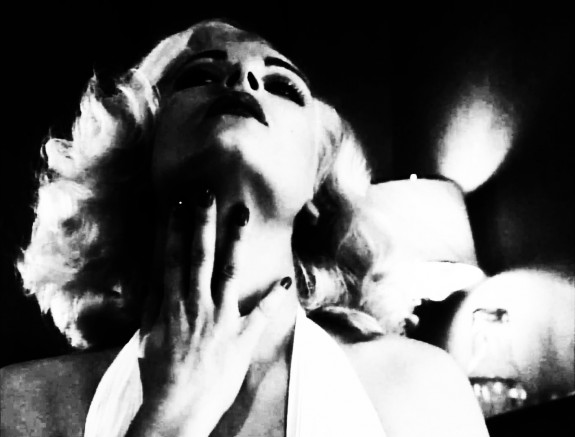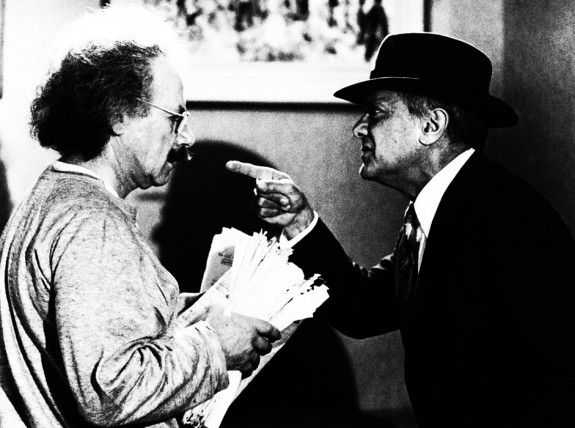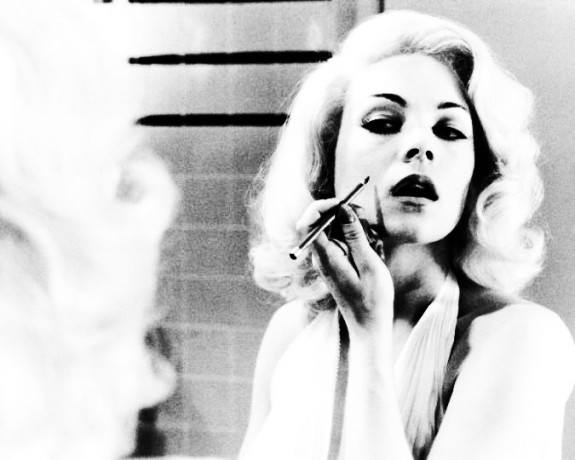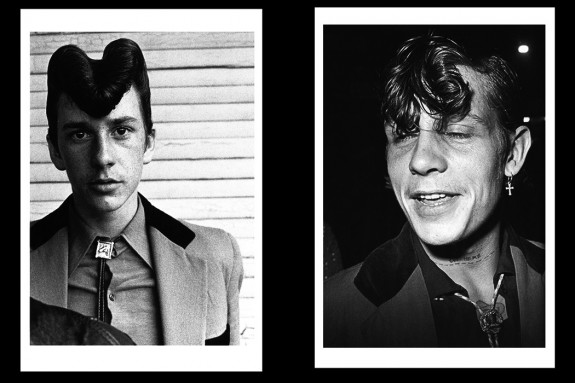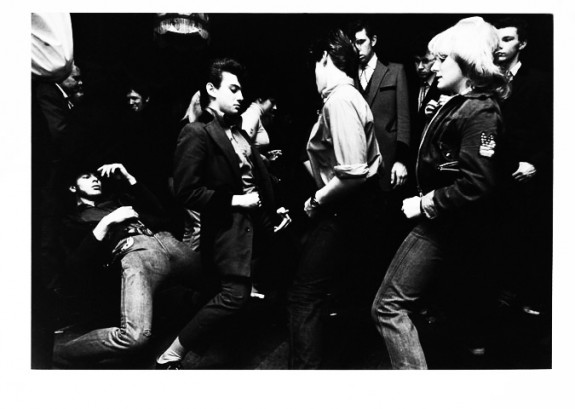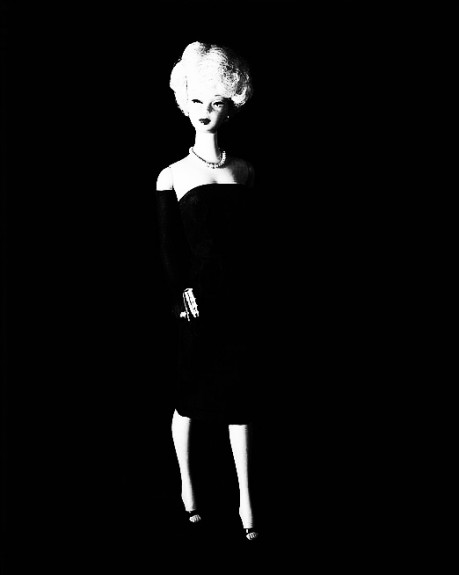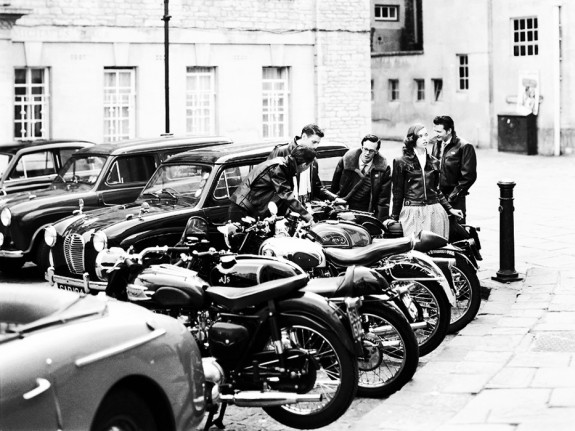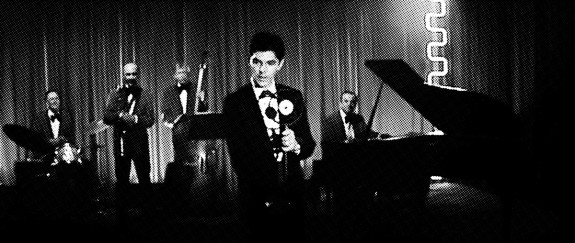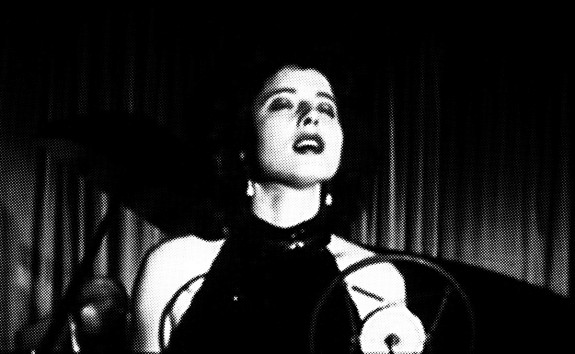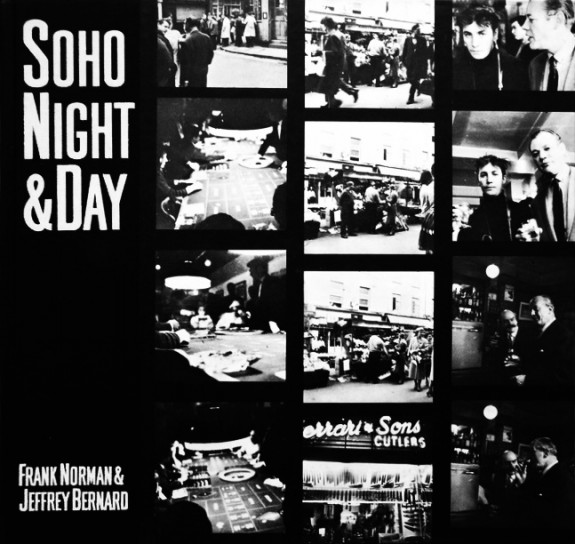Trails and Influences
-
Roswell Angier, American Suburb X, showgirls and a certain rogueishness…
For a fair while I was somewhat obsessed with a handful of images from Roswell Angier’s 1976 photography book/project “…a kind of life”: conversations in the combat zone.
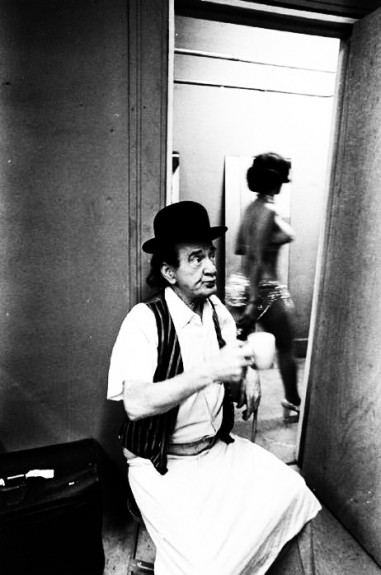 The top two on this page in particular seemed to capture a certain kind of afterhours rogueish that I wanted to, well, capture with my own Afterhours photography/work and they also put me in mind of Mr Joe Whitney’s photograph from outside portal that was The Black Gardenia in Soho, London (see Day #15/365a).
The top two on this page in particular seemed to capture a certain kind of afterhours rogueish that I wanted to, well, capture with my own Afterhours photography/work and they also put me in mind of Mr Joe Whitney’s photograph from outside portal that was The Black Gardenia in Soho, London (see Day #15/365a).(Although I’ve tended to work more in amongst a kind of imaginitive theatre of such things whereas “…a kind of life” is actually a very raw examination of showgirls and others lives amongst the underbelly of a certain area of Boston in the US.)
The photograph below puts me in mind of David Lynch’s work around the time of Blue Velvet (see Day #24/365a) and Twin Peaks – one of those times when life seems to have crossed over into a beyond real story (see Day #13/365a).
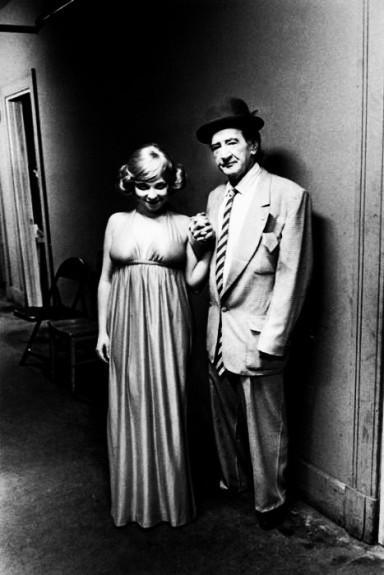 View more on “…a kind of life” at American Suburb X here and here – well worth a wander for a particular take on fine art photography that draws me in while also often having a not-quite-definable transgressive and seediness to it.
View more on “…a kind of life” at American Suburb X here and here – well worth a wander for a particular take on fine art photography that draws me in while also often having a not-quite-definable transgressive and seediness to it.Although now long out of print, you could purchase the book via here or indeed through the ways and wiles of modern technology you can view the whole thing at ExposedtoLight.
(PS Tread carefully when viewing those links – as I said a moment ago, this is life somewhat in the raw).
Peruse the book here.
continue reading -
Expresso Bongo and a surprising Soho Johnny
 “SOHO JOHNNY NEVER HAD IT SO GOOD OR LOST IT SO FAST”
“SOHO JOHNNY NEVER HAD IT SO GOOD OR LOST IT SO FAST”Well, I never really thought I would watch a Cliff Richard film and think “That’s kind of quite decent actually”.
Expresso Bongo is the 1959 (almost) film debut by Mr Richard and is the celluloid adaptation of the West End musical.
At points it wanders into not-so-decent more mainstream cheese and even exploitation but and although it’s no Small World of Sammy Lee (see Day #7/365a), nor a World Ten Times Over or even a Beat Girl, it’s actually a rather decent capturing of that just pre-swinging London and Soho period that I have something of a soft spot for.
Although it doesn’t necessarily have Sammy Lee’s inherent grit/edge, if memory serves correctly it does share some kind of sense of Soho hustle and basement showgirl-ness.
The book was written by Wolf Mankowitz – who also appears in the film credits as a sandwich board man that announces his own credit… which is a nice touch and along with a few others, such as the pin-up girl stage curtains, makes the film at the very least an interesting curiousity.
The film was directed by Val Guest, whose work has made an appearance around these parts before – see Hell Is A City at Day #21/365a – and who was also responsible for the somewhat classic and Flaming Stars song title lending The Day The Earth Caught Fire (and by the 1970s, like much of the UK film industry he had wandered into British smut comedies such as Au Pair Girls and Confessions Of A Window Cleaner).
Places to wander to:
Further Expresso Bongo Soho/London location shots.
Wolf Mankowitz’s novelisation.
Expresso Bongo’s opening credits – a nice snapshot of a certain time and place.Peruse the film here.
continue reading -
Deborah Turbeville – Past Imperfect, filmic ghosts, grain and the deconstruction of traditional photographic perfection
There are a small number of photographers whose work has in some subtle way influenced my own… a certain stylishness, a delicacy of touch, a ghostly creation of otherly worlds quality, a sense of indefinable time and place, a use of grain, texturing and the deconstruction of traditional photographic perfection.
I suppose that number would actually be directly Deborah Turbeville and Sarah Moon (and Ellen Von Unwerth in a slightly different, more overtly playful/stylish/fashion orientated manner).
These are photographers who have a strong fashion background and have taken such aesthetics, genre photography and commissions to somewhere else – nearer to a very personal, fine art vision.
I can’t remember now how I first came across Deborah Turbeville’s work but if you should want a seductive, haunting starting point then I would suggest a first exploration of Past Imperfect, the 2007 book published by Steidl.
This gathers a selection of her work from 1974 through to 1998; the photographs and the book itself are works of beauty, being created and presented in a manner that explores and expands the photography book format and design.
When I was recently re-exploring her work I came across a description of Past Imperfect via photoeye that I thought captured the spirit and stories of her work rather well:
“She pioneered a look of antique decadence, using distressed film and prints to capture models as Miss Havishams in faded fin-de-siecle glory. Some 15 series, structured like short stories or novellas, encapsulate that unique sensibility and elegant aesthetic. They remind the viewer, as one critic has written, of films they would have liked to have seen, and inspire comparisons to Luchino Visconti, Jean Cocteau, Rainer Werner Fassbinder and Joel-Peter Witkin.
Turbeville’s vision is unorthodox-at once haunted and haunting. She creates those effects with the help of favorite actresses and models, largely unknown, acting as a repertory cast. They interpret her endangered species, anachronisms, out of sync with their time and context, playing mutations in a mannequin workshop, statues in a Paris art school, and automatons in a derelict factory. And they help to create a characteristic sense of fragmented dreams, of dislocation, hallucination and time without boundaries-the past imperfect.”
The book is now out of print although details on it can still be found at Der Steidl here. Peruse it further here.
(As an aside and a look into dedication to the book making process, visit How To Make A Book With Steidl here.)
continue reading -
Insignificance and bending the language of cinema / time and space
Now, Nicolas Roeg’s 1985 Insignificance – what a fine celluloid tale.
I think I first saw it back when, not long after it had been made – a fair few years ago – and rewatching it recently I was just as taken by it as I was then.
It concerns the 1950s set story of a somewhat iconic female movie star – known only as The Actress – who visits a somewhat iconic thinker – known only as The Professor in his hotel room, to discuss life and the theory of relativity.
Along the way it takes in McCarthy-esque trials, Mr Tony Curtis as a flop-sweating politician (The Senator), The Actresses husband (The Ball Player), science, pogroms, peace, war – all the little questions.
It is wonderfully accessible, entertaining and looks just beautiful, with Theresa Russell, who plays The Actress, capturing the breathy iconography and shimmering screen sensuality of her character just so; this is a flight of fancy, a playing with instantly recognisable images and tropes from the past and cinema’s history not to present a simulacra of times gone by but to create something new.
 Along which lines, Nicolas Roeg said at the time:
Along which lines, Nicolas Roeg said at the time:“If the grammar of cinema is at all changed or dented, it’s resented far more than in other mediums.”
During its 110 minutes, Insignificance takes the grammar and language of celluloid on a playful – although not always light in tone – journey,
This is defiantly explorative cinema and in many ways it feels like a film of the type that rarely now gets made and certainly if it does, it would be unlikely to have a relatively mainstream release and stars of a certain calibre attached to it.
To be a video-phile, Insignificance is available on a lovely transfer via the Criterion Collection (though you will need a way to play multi-region Blurays if you’re watching it on this side of the pond).
Peruse that and its various other disc encasings here.
continue reading -
Chris Steele-Perkins & Richard Smiths Teds and rough, tough’n’tumble 1970s British subcultural style
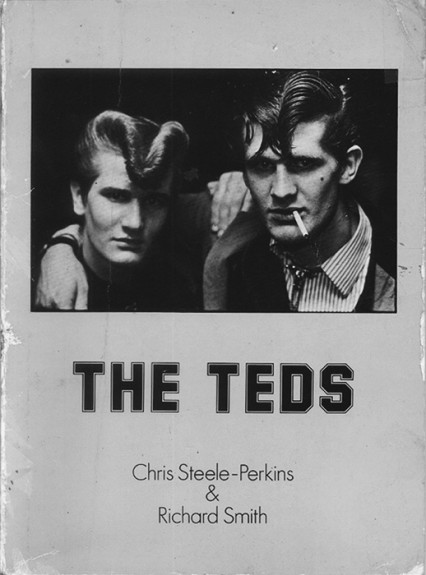
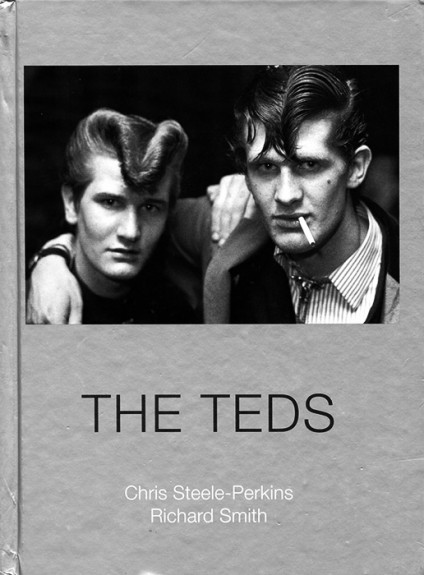 One of the things that struck me when I recently revisited Chris Steele-Perkins photographs in his and Richard Smith’s Teds book is just how much many of the photographs are a document of a certain kind of British 1970s style.
One of the things that struck me when I recently revisited Chris Steele-Perkins photographs in his and Richard Smith’s Teds book is just how much many of the photographs are a document of a certain kind of British 1970s style.Although the sharpness of 1950s Teds (which if you look back at you can possibly see the very early roots of mod concerns) is there but side by side with it is a kind of laddishness at points, a looseness to the style: not loucheness necessarily but if there was a 1970s working class subcultural equivalent I’d be using it about now.
Which sounds like I’m knocking the book but I’m not – I think it’s a fine piece of work, a fine snapshot of a particular cultural gathering and point in time.
In some ways, the photographs reminds me of the impression Richard Allen’s 1970s skinhead fiction books can leave you with – tough, rough and tumble 1970s subcultural style and living – without the more overt harshness and violence of Mr Allen’s books.
I suppose one of the things that the book brings home is just how much the 1970s incarnation of teds / teddy boys / teddy girls was an adapting to then modern day times, styles and attitudes, rather than being a slavish recreation.
The original 1979 edition is now long gone and considerably out of print, as is the second 1987 edition, also published by Travelling Light / Exit and I’m afraid to say that the third 2002 edition published by Dewi Lewis has also wandered off the shelves (one of the earlier editions is on the left above, the Dewi Lewis edition is on the right above).
…you can find a copy but it’ll cost you a few pence or more – interestingly when I looked here the original edition was available at not all that much more than the 2002 edition.
Visit the book at Dewi Lewis Publishing here.
View a selection of images from the book at Pony Boy Magazine here and Chris Steele-Perkins here.
continue reading -
David Levinthal and populuxe archetypes…
I’ve been drawn to David Levinthal’s work for a while… he creates photographic dioramas and still lifes that reflect particular cultures, activities and periods in history, work that could be seen to be a forerunner to the likes Slinkachu’s miniature street life photography that is also created in a similar manner.
On some levels David Levinthal’s work such as his Barbie Millicent Roberts series could be seen as technically proficient photographs of, well, toys…
…but something else seems to happen in the stillness of his photographs and their objects, even when they are shot without overtly contextualising backgrounds or used to create or recreate particular actions, stories and histories.
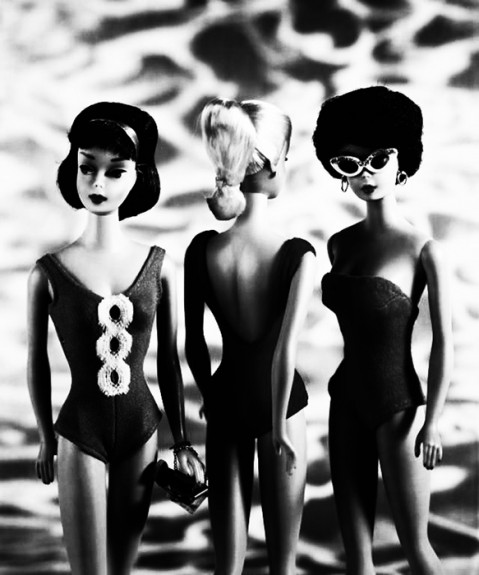 The Barbie Millicent Roberts series predated the Mad Men-esque trend for the revival of populuxe styling by nearly a decade, alongside a return to Marilyn Monroe like glamour and it takes an iconic toy/doll from over the seas and seems to return it to its pure archetypal form – almost becoming 1950s/1960s prototypes for an idealised American womanhood.
The Barbie Millicent Roberts series predated the Mad Men-esque trend for the revival of populuxe styling by nearly a decade, alongside a return to Marilyn Monroe like glamour and it takes an iconic toy/doll from over the seas and seems to return it to its pure archetypal form – almost becoming 1950s/1960s prototypes for an idealised American womanhood.…and here and there, although not as inherently dark in subject matter as say his late night hustler Modern Romance work, the dolls in this series start to tumble towards a Cramps-esque, Poison Ivy-like take on such things and to step closer to mondo, b-movie, beach-party, bad girl-isms.
Visit David Levinthal here (tread gently some of his work is of a more grown-up nature, shall we say).
Peruse the Barbie Millicent Roberts book here.
continue reading -
Bone-Box, feral dreams and flooding the past…
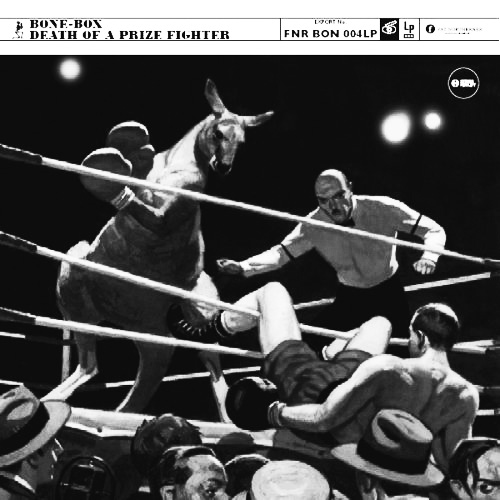 Well, talking of Bone-Box, I’m not sure if I could encapsulate their world and work better than this quote from the venerable British Broadcasting Corporation:
Well, talking of Bone-Box, I’m not sure if I could encapsulate their world and work better than this quote from the venerable British Broadcasting Corporation:“Bone-Box weave webs of faded fairytales and cross palms with slivers of shattered tales of the everyday thrown from an out of control carousel… a ghostly gospel of drama and dented dreams far more feral than the plaintive lap-steel sometimes suggests. As an epic whole, they are The Master and Margharita filmed by Glenn Ford and scripted by Tom Waits with executive producer Leonard Cohen.”
A particular favourite of theirs around these parts is Talking Christ Down From The Cross, which can be found on the Death Of A Prize Fighter album.
A paean to a lost soul I think: “First he took to drinking, what better way to speed time… but he took to drowning until he flooded his past…”.
Even though I must have listened to it a fair few times over the years, it has still just made my hair stand on end as I’ve listened to it.
I just loose myself and wander off somewhere when I hear the opening notes of this. Wistful, sad, uplifting indeed.
Fine cover work to: the lost age and art of entertaining a crowd in a very particular way. The painting was commissioned by Jay Taylor* for the album. Commitment to the cause and all that.
(Mr Jay Taylor in a variety of hirsute stances.)
You can listen to/make your own the song on various zeros and ones ether victrolas: last.fm and Bandcamp... or seek them out at Boomkat here and peruse them here
.
*Head chap round Bone-Box towers, former Goldblade-er, previously organiser of all things band/live music orientated at The Night and Day in Manchesters and currently organising such things at The Ruby Lounge in same said city. Also a very decent gent it must be said. Somewhat influential and informative in the early days of Afterhours via an interview/natter we spent some time on a few years ago now. Tip of the hat to you sir.
continue reading -
Nick Clements, cultural memory and vintage simulacra / re-creation
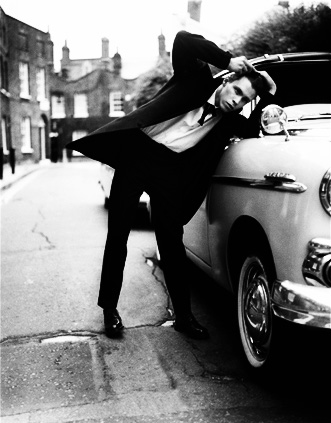 In my own Afterhours work I don’t think the intention had ever been to create an exact replica of times gone by; more to capture a particular spirit of something – a re-imagining that was in part inspired by and filtered through my own experiences, alongside personal cultural explorations, memory and representations…
In my own Afterhours work I don’t think the intention had ever been to create an exact replica of times gone by; more to capture a particular spirit of something – a re-imagining that was in part inspired by and filtered through my own experiences, alongside personal cultural explorations, memory and representations……and along the way, an interview I read with photographer Nick Clements in Nude magazine (not a nude magazine please note) which quite possibly helped to bring together and coalesce my ideas.
Some of the concepts Nick Clements talked about in that interview seemed to somewhat haunt me for a fair old while – possibly in the way that William Gibson talks about ideas not falling fully formed from his brow, more in the intangible sense that he saw something sprayed on the side of a skip and it haunted him and that formed the basis for a story.
Along which lines, from the interview:
“(My photographs are) reconstuctions… but not of any existing photographs or illustration. Instead they have been reconstructed partly from the memories of those who were there at the time, and partly from my own memories of events, films and photography of the period… the perfect thing about memory is that it is imperfect…
 “…if I did it from photographs that would be re-enactment and what I’m doing is re-creation. One comes from memory and feeling and intuition and the other is a historical phenomenon. Many of my “memories” stem from pop culture as seen through television programmes like Happy Days…
“…if I did it from photographs that would be re-enactment and what I’m doing is re-creation. One comes from memory and feeling and intuition and the other is a historical phenomenon. Many of my “memories” stem from pop culture as seen through television programmes like Happy Days…“We loved Happy Days as kids but even then we didn’t take it seriously as an exact re-creation. In the same way, the film American Grafitti had lots of historical errors in it: the length of hair and so on, but the emotion that George Lucas put over had a very authentic ring to it.”
The full interview can be found in Bare Essentials: The Best Of Nude Magazine 2003-2011 – which can be found and purchased as part of a somewhat bargainous package along with The Graphic Art Of The Underground.
Nick Clements Simulacra book, where I first saw his work collected together is sadly somewhat rare as hen’s teeth but you can find other of his publications via his Men’s File archive or a collection of related work in The Best Of Men’s File, published by Korero Books.
continue reading -
Now It’s Dark; Blue Velvet and a sublime touch of Angelo Badalamenti courtesy of Ms Rossellini
There was a point where David Lynch seemed to be the go-to chap for accessible but experimental thrillers – around the mid eighties to the turn of the decade – when Blue Velvet and Wild At Heart were either peering into the underbelly of the American picket fence dream or taking the viewer or a rollercoaster ride with Sailor and Lula.
As I was wandering along to this here computer this morning I wandered what category/genre you would put Blue Velvet into? It has elements of neo noir but I’m not sure that’s quite right. Transgressive noir? That’s possibly getting near to the spot.
Anyway, one of the highlights in a film full of highlights (if that’s the right word for a celluloid tale such as this) for me and a part that can stand on it’s own separate to the film is Ms Isabella Rossellini’s music montage in the Slow Club – all crushed velvet plushness, seediness, broken dreams and rather lovely blue lighting that puts me in mind of Kiera Knightley’s tube station during the Blitz singing performance in John Maybury’s Edge Of Love (another director who somehow manages to sneak really rather experimental elements of film making into often quite accessible films).
When I watch it, it tends to make me think (hope?) that somewhere in the world there’s a full album and maybe even a full recording of this performance – well, without the unsettling elements and story that accompany it.
More details on Mr Angelo Badalamenti’s rather fine soundtrack here. Watch the montage sequence here.
Peruse the film here
.
continue reading -
Soho Night & Day – a lost book of a lost world…
Talking of lost corners of the world (see Day #29/365)…
Part of a (smallish) library of books that document Soho back in the day… I used to have this Soho Night & Day book – I think I bought it for tuppence ha’penny back in the day from a charity shop or maybe a second hand shop…
…now, well, it’ll cost you a pretty penny, particularly the hardback edition.
It’s a raw written and photographed snapshot of Soho in the mid to late 1960s and now seems like a capturing of a world far, far away, particularly as the redevelopment (or literal demolishing to give it a probably more precise word) of that corner of the world has gathered pace somewhat.
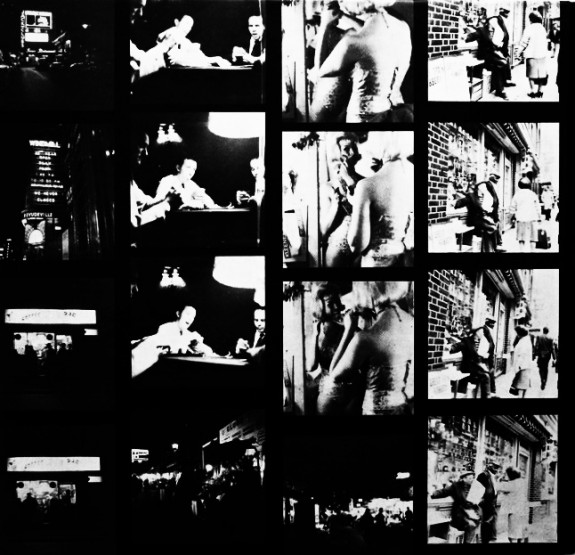 I stumbled upon this description of the book online which seemed to sum up the book/s rather well:
I stumbled upon this description of the book online which seemed to sum up the book/s rather well: “…a gravelly love letter to Soho, London. About 40 or 50 so real life vignettes written by Frank Norman, detailing both the history of the once notorious streets of Soho (Old Compton, Dean, Brewer, Greek, Poland, Berwick, Wardour, Romilly) and the stories of the larger than life characters who once graced its streets, restaurants, clip joints, alley ways, bars and clubs like old neon bulbs which once lit up a once upon night but whose names are largely forgotten or have entered urban folklore.”
“…a gravelly love letter to Soho, London. About 40 or 50 so real life vignettes written by Frank Norman, detailing both the history of the once notorious streets of Soho (Old Compton, Dean, Brewer, Greek, Poland, Berwick, Wardour, Romilly) and the stories of the larger than life characters who once graced its streets, restaurants, clip joints, alley ways, bars and clubs like old neon bulbs which once lit up a once upon night but whose names are largely forgotten or have entered urban folklore.”(Indeed, the book was written/photographed by two of those whose names have to different degrees entered those annals of inner city folklore from lives, living and (sometimes) working amongst those streets – Frank Norman and Jeffrey Bernard.)
Peruse the paperback here and if it’s still there – a resonable sized preview of the book here. The above writing can be found in full here.
continue reading
